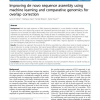5 search results - page 1 / 1 » Improving de novo sequence assembly using machine learning a... |
BMCBI
2010
13 years 4 months ago
2010
Background: With the rapid expansion of DNA sequencing databases, it is now feasible to identify relevant information from prior sequencing projects and completed genomes and appl...
BMCBI
2006
13 years 4 months ago
2006
Background: ESTs are a tremendous resource for determining the exon-intron structures of genes, but even extensive EST sequencing tends to leave many exons and genes untouched. Ge...
BMCBI
2011
12 years 11 months ago
2011
Background: Next-generation sequencing technologies have led to the high-throughput production of sequence data (reads) at low cost. However, these reads are significantly shorter...
BMCBI
2010
13 years 4 months ago
2010
Background: Finishing is the process of improving the quality and utility of draft genome sequences generated by shotgun sequencing and computational assembly. Finishing can invol...
BMCBI
2008
13 years 4 months ago
2008
Background: Most gene finders score candidate gene models with state-based methods, typically HMMs, by combining local properties (coding potential, splice donor and acceptor patt...

